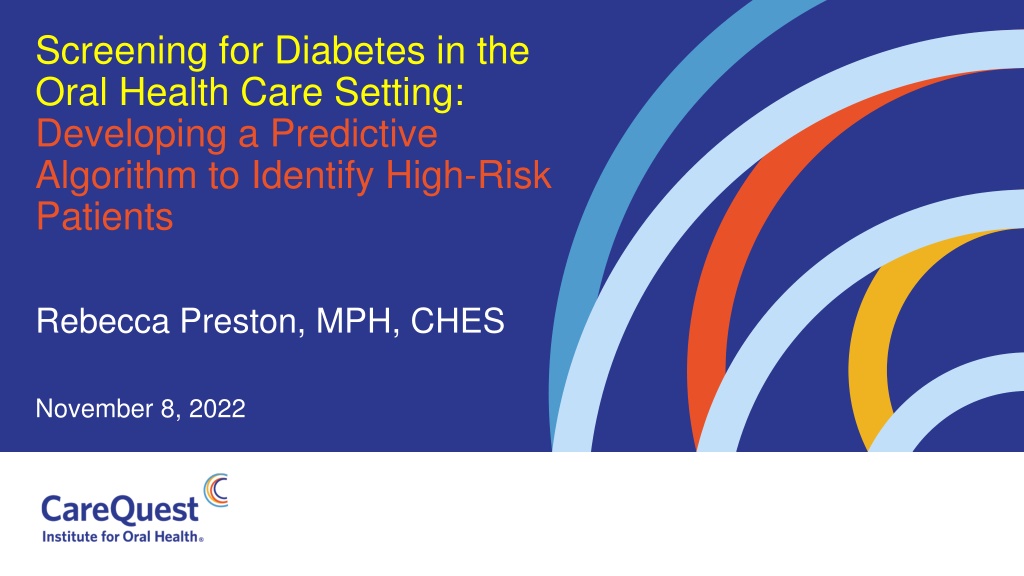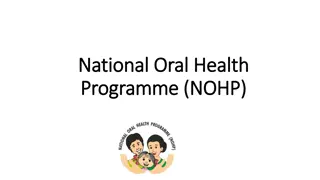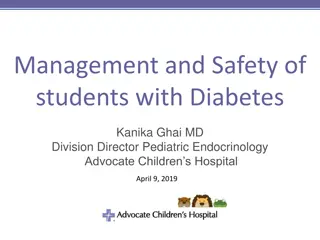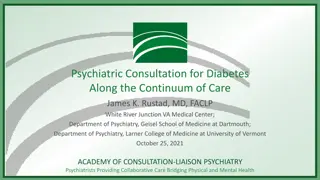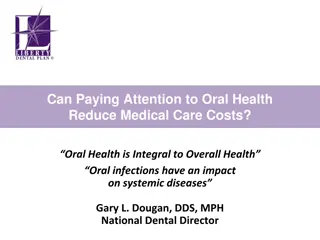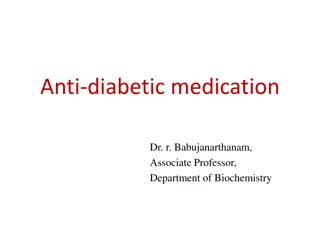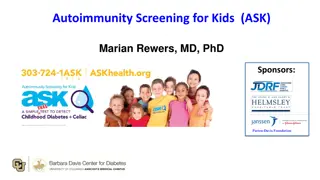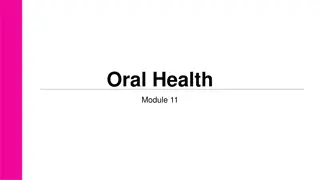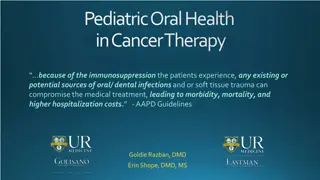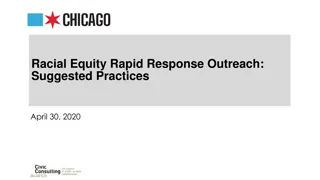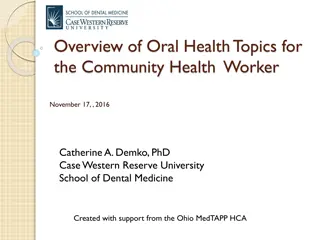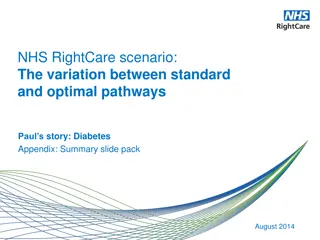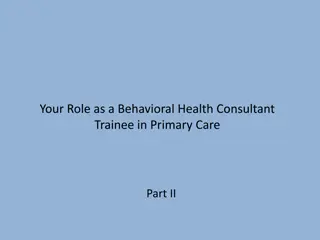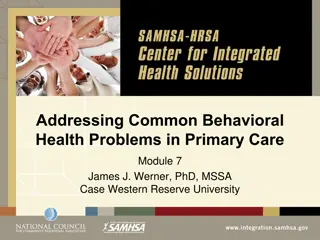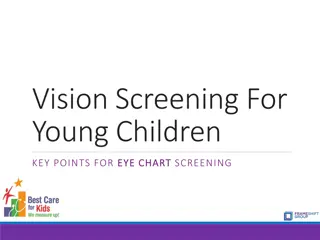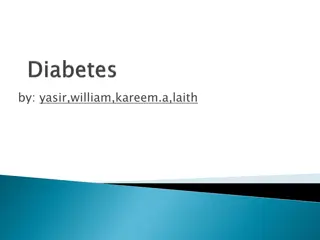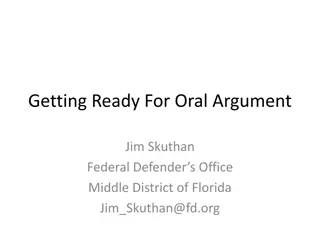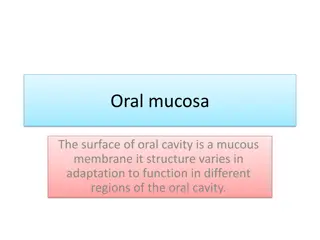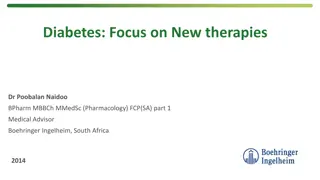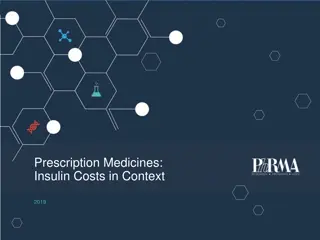Integrating Oral Health Screening for Diabetes Risk in Primary Care
This presentation discusses the importance of screening for diabetes risk in oral health care settings through the development of a predictive algorithm to identify high-risk patients. Medical-dental integration is highlighted as a model of care that supports individual and population health by incorporating dental medicine into primary care. The bidirectional relationship between diabetes and periodontal disease is explored, emphasizing the potential cost savings and health benefits of early detection and treatment. Strategies for enhancing collaboration between oral health and primary care providers are also outlined to improve patient outcomes.
Download Presentation

Please find below an Image/Link to download the presentation.
The content on the website is provided AS IS for your information and personal use only. It may not be sold, licensed, or shared on other websites without obtaining consent from the author. Download presentation by click this link. If you encounter any issues during the download, it is possible that the publisher has removed the file from their server.
E N D
Presentation Transcript
Screening for Diabetes in the Oral Health Care Setting: Developing a Predictive Algorithm to Identify High-Risk Patients Rebecca Preston, MPH, CHES November 8, 2022
Disclosures [Rebecca Preston, Madhuli Thakkar-Samtani, Dustin Holloway, Angela Kyomugisa, Rebekah Matthews, Christine Kanan, and Eric Tranby] Financial Disclosure: Speakers do not have any relevant financial relationships to disclose. The NC Oral Health Section Continuing Education Program is responsible for ensuring the content, quality, and scientific integrity of all continuing education activities. No commercial support has been received for this continuing education activity.
Oral Systemic Connection Simply put, a disease in the mouth affects the rest of our systemic wellbeing. 4
What is Medical-Dental Integration? Medical-dental integration is an approach to care that integrates and coordinates dental medicine into primary care and behavioral health to support individual and population health. It also promotes the practice of oral health providers integrating services such as screenings for chronic diseases into their care. It is a model of care that encourages providers to create comprehensive care plans for the whole person. Source: CareQuestInstitute 5
Oral Health and Primary Care Providers Role in Integration Screening and risk assessments Patient centered education Chronic disease management Bidirectional referrals Develop resources that address barriers to care Co-located practices normalize communication of relevant information bidirectionally Create referral networks for non-co-located practices to collaborate Efficient case management 6
Diabetes and Oral Health Estimated Combined Cost Savings for T1DM, T2DM, and Pre/Borderline Diabetes by Medicare Type Approximately 3.4% of adults with diabetes mellitus (DM) are undiagnosed (CDC National Diabetes Statistics Report) DM and periodontal disease (PD) have a suggested bidirectional relationship; those with PD have an increased risk of DM and vice versa (Mealey & Oates, 2006) Treatment for PD results in HbA1C reduction and decreased DM-related health care costs (CareQuest Institute, 2022; Chapple & Genco, 2013; Nasseh, Vujicic, & Glick, 2017) Another Billion Reasons for a Medicare Dental Benefit, CareQuest Institute 7
Diabetes Integrated Care Prototype (DICP) We developed a predictive algorithm using demographics, medical and dental history to identify patients at high risk of, but not previously diagnosed with, DM. Exclusion criteria: Patients outside the ages of 21-64, history of uncomplicated or complicated diabetes, no history of periodontal disease (swollen or bleeding gums, loose teeth periodontal pockets), known intellectual disabilities and patients who are pregnant Across five health centers, patients were approached to have their A1C levels tested (point-of-care HbA1C tests administered chairside) during their dental appointment, primarily by dental hygienists. Patients with prediabetes (A1C = 5.7% - 6.4%) or DM (A1C > 6.5%) were referred for follow-up medical care. Patients also completed surveys about their screening experience. 8
Clinic Workflow 1. A patient is flagged as high risk for diabetes by the diabetes algorithm. 2. A1c screening will be initiated by a dental provider following patient consent. Consents were included at the start of the visit as part of overall consents specific to each health center s procedures or at the time of risk discovery. 3. If the patient s A1c results are within the prediabetic or diabetes range, the dental provider will recommend/refer patient schedule a visit with their PCP for a complete evaluation. 4. Depending on staffing capacity, office administrators will call the patient s PCP at the end of the dental visit to schedule the next available appointment with their PCP or same day urgent care appointment for patients whose A1C is above 9. 9
Results Patients (N=845) screened One in five (21.8%; N=184) screened positive Pre-diabetes (N=130; 15.3%; HbA1C=5.7-6.4%) Diabetes (N=54; 6.3%; HbA1C=6.5-8.0%) Patients were 3-4 times more likely to be diagnosed with diabetes than expected. 10
Patient Survey Results 50% of the patients screened visit the same center for both medical and dental care 95% of patients intend to follow up with their primary care provider at the request of their oral health provider 97% of patients stated that they were very comfortable or comfortable while being screened for diabetes at their dental office. 98% of patients rated their overall experience of having an A1c test performed in the dental office as good or very good. 11
Post DICP Survey The diabetes integrated care prototype was useful to your practice. Strongly Agree 75% Providers, clinic staff, and project management teams across all clinics participated in a post project survey Agree 25% Disagree 0% Strongly Disagree 0% 0% 10% 20% 30% 40% 50% 60% 70% 80% 12
As an oral health provider, how likely are you to permanently incorporate A1C testing into your dental care protocol? Highly likely 50% Likely 50% Unlikely 0% Highly unlikely 0% 0% 10% 20% 30% 40% 50% 60% 13
Barriers faced during the duration of DICP study Accurate patient schedules that patients were pulled from Patients were already diagnosed as diabetic Patients no-showing and cancelling appointments Lack of staffing to support project Patient no-show to appointments More thorough training Patient participation Workforce shortage Implementation of new EMR (electronic medical record) 14
Improvements recommended for Diabetes Integrated Care Prototype More patient candidates to accommodate for schedule changes Searching for patients against the EMR database to rule out More thorough training Recommend increasing the number of eligible clients per week Established dental only patients who are already diagnosed as diabetic 15
Stay Connected Sign up for our newsletter to receive timely oral health news, stories, resources, and education. or visit carequest.org/register 16
